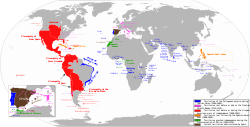Spanish discoveries
The Spanish Empire (Spanish: Imperio Español; Latin: Imperium Hispanicum), historically known as the Hispanic Monarchy (Spanish: Monarquía Hispánica) and as the Catholic Monarchy (Spanish: Monarquía Católica) was one of the largest empires in history. From the late 15th century to the early 19th, Spain controlled a huge overseas territory in the New World and the Philippines, what they called "The Indies" (Spanish: Las Indias).. The Spanish Empire was the first global empire in history, the foremost global power of the 16th century and the first half of the 17th, reaching its maximum extension in the 18th century, and the first empire to be called "the empire on which the sun never sets"
Castile became the dominant kingdom in Iberia because of its jurisdiction over the overseas empire in the Americas and the Philippines. The crown's main source of wealth was from gold and silver mined in Mexico and Peru. The structure of empire was established under the Spanish Hapsburgs (1516–1700) and under the Spanish Bourbon monarchs, the empire was brought under greater crown control and increased its revenues from the Indies. The crown's authority in The Indies was enlarged by the papal grant of powers of patronage, giving it power in the religious sphere. An important element in the formation of Spain's empire was the dynastic union between Isabella I of Castile and Ferdinand II of Aragon, known as the Catholic Monarchs, which initiated political, religious and social cohesion but not political unification.Iberian kingdoms retained their political identities, with particular administration and juridical configurations. Although the power of the Spanish sovereign as monarch varied from one territory to another, the monarch acted as such in a unitary manner over all the ruler's territories through a system of councils: the unity did not mean uniformity. In 1580, when Philip II of Spain succeeded to the throne of Portugal (as Philip I), he established the Council of Portugal, which oversaw Portugal and its empire and "preserv[ed] its own laws, institutions, and monetary system, and united only in sharing a common sovereign." The Iberian Union remained in place until in 1640, when Portugal overthrew Hapsburg rule and reestablished independence under the House of Braganza.
...
Wikipedia


